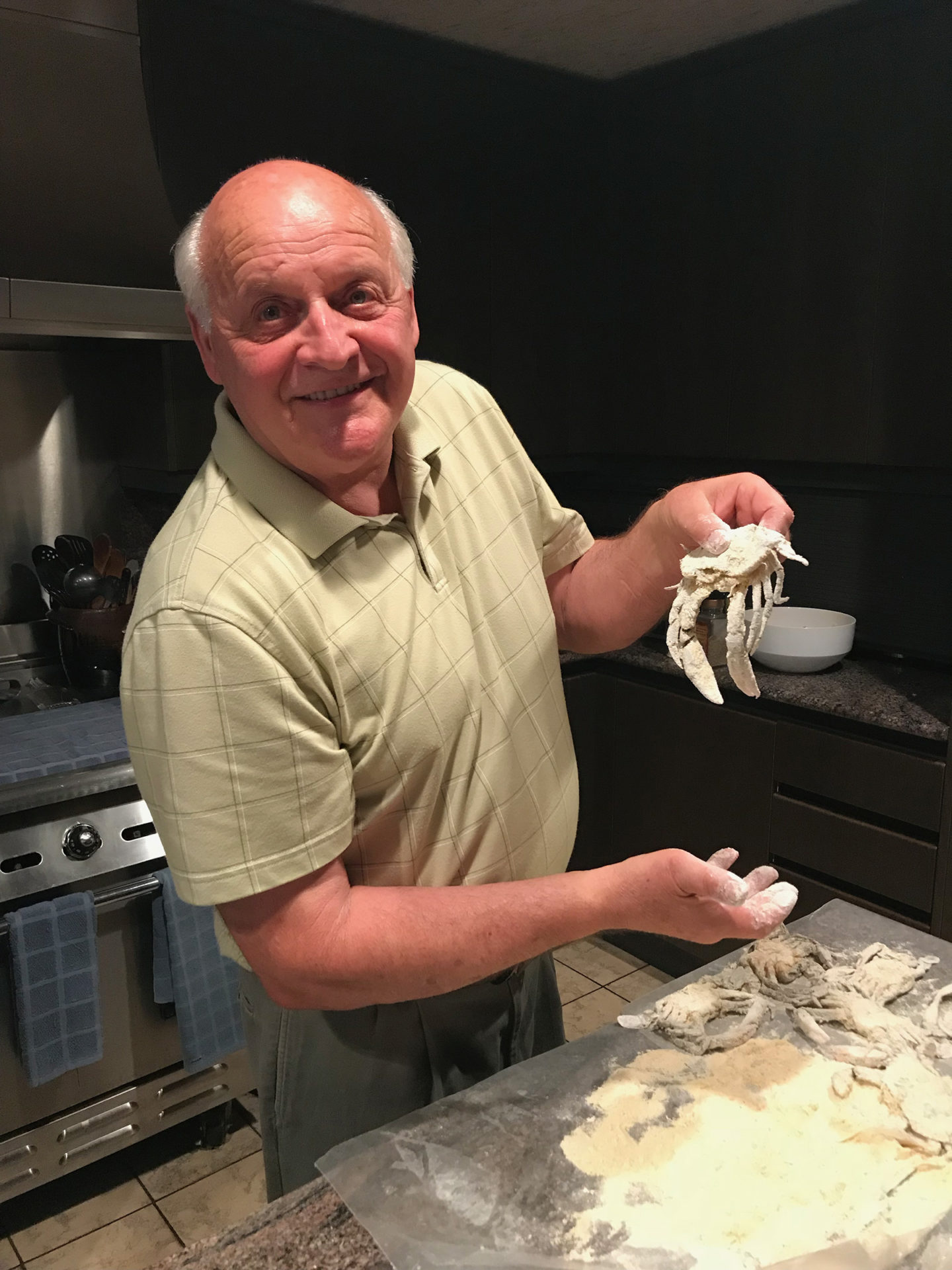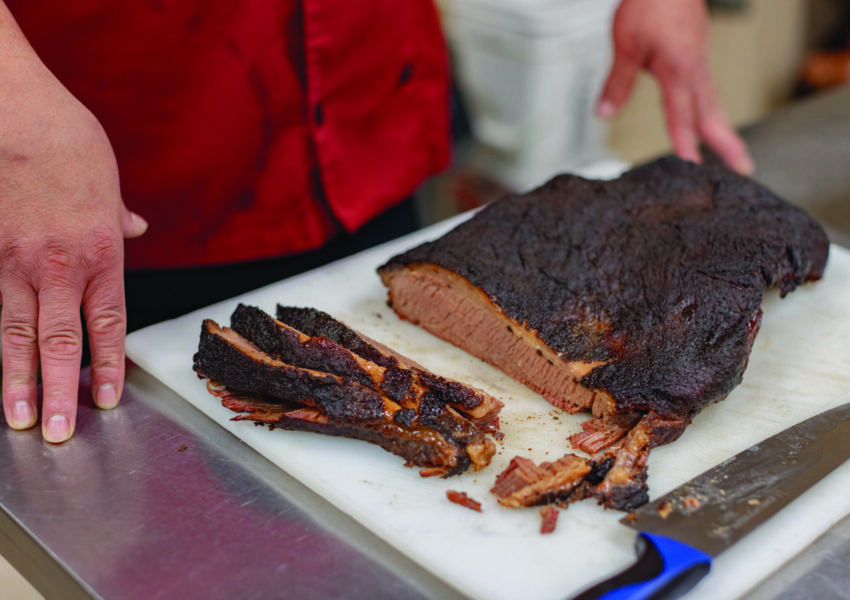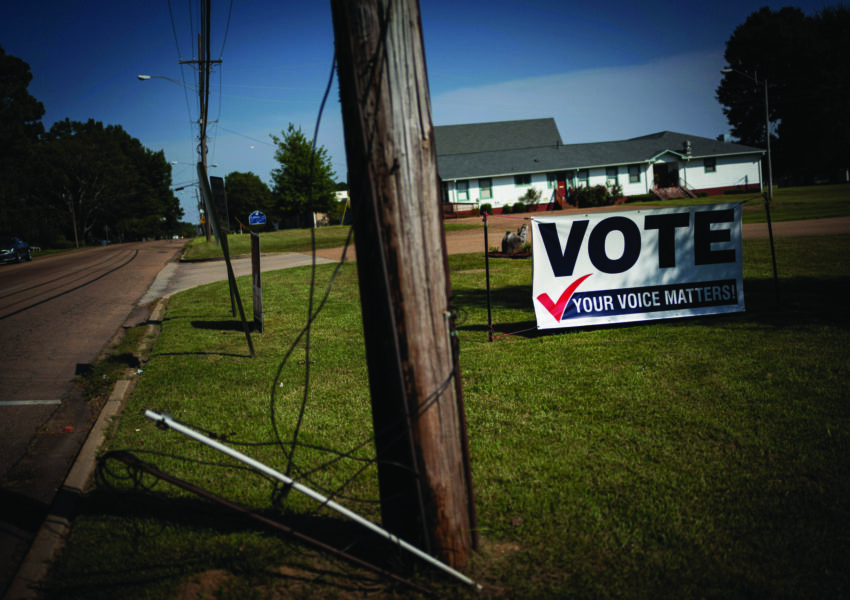Busted Sooks, Rank Peelers, and White-Belly Jimmies Mudlarking words for crabs
by Bernard L. Herman
It’s an early summer afternoon at Bayford. A breeze kicks up, the air is clear and fresh, the sunlight on bright white boat hulls and shimmering water is blinding. Crabbers tie up at Bayford wharf in succession.
Each boat with its two-man crew offloads bushels of Chesapeake Bay blue crabs. Andrew Bunce is there tabulating and fulminating about catch, quality, and people who can’t count. In the shadow of a seafood truck, he’s created an office furnished with a bushel basket stuffed with blue crabs just caught and landed. The crabs wriggle and scratch in their packed confinement as Andrew fields and confirms orders on his cell phone and writes down the catch counts hailed from the wharf. The sound of motors shutting off and voices drifts into the oyster house. H. M. Arnold, the oyster house proprietor, grabs a bushel basket and heads out to the dock. H. M. is there for the peelers that he will shed into soft-shell crabs. “Docking fee,” Andrew smiles.
Folks come and go exchanging greetings, one-liners, and rough good humor. Drivers load their refrigerated trucks, consolidate the contents of bushel baskets, and organize their cargo by the crabs’ sex, size, and condition: number ones, number twos, number threes…. Listening to the back and forth, there is, I realize, a code for crabs and a lot of words to complicate it.
Walter Brunk works with his father, Russell, unloading their boat.
“So, what’s the count?” Walter shouts to Andrew.
Andrew calls back, “I got you for three and two-thirds ones.”
Russell affirms, “Yep.”
Andrew adds to the inventory, “Two and two-thirds twos.”
Russell, “Yep.”
“Two threes. Two and a third fours,” Andrew hollers, “And one busted.”
Russell confirms, “Yep. Sounds good to me.” He turns to his son, “What’ve you got? Three threes, Walt?”
Walter replies, “Two threes.”
Russell asks, “What’s this here?”
“Busted sooks,” Walter responds.
Andrew confirms, “You got two threes, two and two-thirds twos.” Andrew cautions, “They got to be hard and five and a half.”
Walter stakes his reputation, “I stand by them today, because I touched them.”

I ask about fours and busted sooks. “White crabs,” Russell enlightens me, “are fours and busted sooks are fives.” Then he says, “They’ve got a different system here.” I take his word for it. Russell senses my confusion and helpfully explains, “Number ones are five and a half and on up and a hard crab. A good full-meat crab. The twos are five inches and a good hard crab. The threes are clean sooks, shedded sooks. Fours are just white-belly jimmies—shedded ones. Ones that are hollow, ain’t got much meat in them, are fours.” He illustrates, “Like these. See, they’re just shedded, they’re not real hard. They’re still a little soft under there. There’s not much meat in them.” A five, he clarifies, “that’s a busted sook.” Referring to the watermen of Tangier Island further up the bay, he elaborates, “Tangiermen call them lemons because they’ve got that yellow sponge on them. Cushions. That’s a busted sook, too. That’s what Tangiermen call them—cushions and lemons.” The number system, he notes, “They’ve always had that for going up the road and selling them. That’s what they go by.” A glossary, I speculate, could be useful. Russell agrees, “So people understand what the hell the lingo is. They’ve probably got a whole other language up there in Maryland.”
William W. Warner’s masterful and poetic book of 1976, Beautiful Swimmers, chronicled the crab industry, concentrating on the Crisfield area and its environs on the Eastern Shore of Maryland. He provided sidebars to the crabbing industry in Virginia with a particular emphasis on winter crab dredging, when boats would work the bottom for dormant female crabs slumbering until the arrival of the springtime mating season. Andrew Bunce remembers crab dredging without pleasure: “I was crab dredging, which used to be our winter fishery. I ain’t the only one this has happened to. You pull these big steel dredges on the bottom that dig the crabs out when they’re hibernating for the winter and the hydraulic hoses broke. My hand was caught in the dredge and I went straight down to the bottom with the dredges. It wasn’t fun! It was winter! It was January! We were working in a fleet of probably sixty or seventy boats. Some people rode right by me because they didn’t want to miss a lick on the crabs.” He laughs grittily.
“Of course,” Andrew continues the tale of his journey to the bottom of the bay, “the boat looked like it was about a mile away, although it was probably only fifty yards. I guess I was panicking. The guy I was working with, he picked up one arm and throwed me right over the top of the dredge into the bottom of the boat. I think he was more scared than I was! Still had my boots on. Some people drowned with that happening.” He looks out over the creek on this warm afternoon, “Hell, that was about one of the commonest jobs you could mate on was crab dredging. You were working grass. You were out in the cold. It’s just nonstop work. It’s a labor-intensive job. They’ve cut it out, trying to make the crabs come back. I don’t care if they bring it back or not. You won’t see me doing it!” Our conversation stutters and breaks on a rising breeze. Later I tell the tale to Steve Bunce, Andrew’s older brother, and he shakes his head, “He’s hard. You can’t kill that son of a bitch!”
The trade in blue crabs remains an important part of the Eastern Shore economy, and it traces its origins back to the arrival of the railroad and advances in food processing and preservation in the late 1800s. A correspondent to the Accomac newspaper the Peninsula Enterprise enthused in 1888 about “the possibilities of the crab industry and the source of revenue it opens up to many of our people at a season of the year when they are comparatively idle.” Offering proof, the editor quoted an Onancock businessman, “‘This is our second year in the crab business at this point, and on last Monday and Tuesday we bought about 13,000 crabs and on those days shipped to New York 860 dozen soft crabs…. The wages of the ‘crabbers’ amount to from $1 to $6 a day.” A subsequent contributor to the Peninsula Enterprise wrote in 1896, sharing the particulars of another firm, that “has engaged quite extensively in the soft crab trade, and also utilizes thousand[s] of hard crabs. He has the hard crabs steamed and the meat picked out, which he ships to market in gallon tin cans. He has employed in his crab factory at Franklin City from 15 to 25 women and children.” Little remains of Franklin City today, and crab-picking operations on the Eastern Shore of Virginia are a dwindling enterprise.
Precision seasons the language of terroir.
There is much to be learned from words for crabs and how vocabulary expresses the taste of place at a point where natural history, commercial enterprise, and community life come together. Words for crabs break down into overlapping categories. First, there is the Latin (Callinectes sapidus), which translates as beautiful swimmer with the afterthought of savory appended. There are words that describe the crab through the arc of its life cycle. There is an abundance of words, some overlapping, that place the crab in its market and kitchen histories. Kenny Marshall, retired waterman and decoy carver, cuts to the essence of the labor those many words for crabs perform. “There is no such a thing as a crab,” Kenny Marshall announces. “My dad,” he says, “used to get on me if I said, ‘I sent my ball into that tree.’ He’d say it landed over by that maple tree or that black walnut tree or that cherry tree. It’s not just a tree! Call it what it is. Same thing as with a hammer. There’s no such thing as a hammer. It’s a claw hammer, a ballpeen hammer, a carpenter’s hammer, a rip hammer.” Kenny is laughing, “You don’t just have a crab!”
Point taken. Precision seasons the language of terroir.
Writing on the crab industry in Maryland for Field and Stream in 1905, Winthrop Roberts provides some basic terminology that serves as a starting point:
There are six stages of a crab’s life, commonly classified as follows: First the “hard crab,” or one [in] its natural condition; second, a “snot,” or one that has just entered the shedding stage; third, a “peeler,” when the old shell has begun to break; fourth, a “buster,” when the new shell can be seen; fifth, the “soft crab”; sixth, a “paper-shell,” or “buckram,” when the new shell is beginning to harden. During hot weather it takes from two to three days for a “snot” to become a “peeler.” One tide will often change a “peeler” to a “buster,” and another from a “buster” to a soft crab. A few hours after shedding the crab has reached the “paper shell” stage, and within three days the hardening process is completed.
I grasp the process, but the term “snot” is news to me. I need help and turn to H. M. Arnold.
H. M. tutors me on the Eastern Shore of Virginia crab lexicon. Cleaning spot in the cool interior of the oyster house after a summer dawn of gill-netting on Nassawadox Creek, we listen to radio news reports of the rarity of a tornado that hammered the shoreline just to our south a week earlier. H. M. lays out the crab basics that others will embroider in conversations to come. He begins, “You got the he-crab, the he-peeler, then you got the jimmy. Number one jimmies are five and a half up. Then number twos, they’re five to five and a half for the jimmy.” In the progression, H. M. provides, a he-crab is an immature male, and the mature males, jimmies, are classified by size for market. Andrew amplifies this point, “Males, they’re called jimmies. They grade them out different sizes. You have your number ones, which are five and a half and up. You have your jumbos, which are six inches and up. Your number twos, which are five- to five-and-a-half-inch crabs.”
Words for female crabs are a bit more involved, but the fundamental principles of categorizing crabs in the lingua franca of the marketplace holds sway. “The female,” H. M. starts, “she doesn’t have to have any size. Once she’s mature, the female, she’s done all she’s going to do as far as getting any size. Could be a small one; could be a big one.” Andrew helps out, “You have your females, which they call them sooks, and they go any size. When they have their eggs, they call them busted sooks, lemons, and sponge crabs and cushions. They’re the ones that are getting ready to rub their eggs off.” Kenny Marshall elaborates, “A sponge crab, that’s an adult sook who has dropped her egg apron out and you can see the eggs in under her apron. They’ll start off real pale orange and get darker and darker and darker until they’re almost black just before they hatch out.”

Andrew explains, “Then you have your immature females, which are called she-crabs. I’ve heard the immature ones called virgin females. I heard that one last year when some guys from Carolina sent a bunch of she-crabs up, and they told the truck driver they were virgin females,” Andrew laughs. “A crabber will pull your leg in a second to sell his stuff,” he snorts with good humor. Under the umbrella of the female crabs, I learn of the she-crab (in addition to virgin, I’ve heard sally), sook (a clean sook for market is a number three), busted sook or lemon or cushion or sponge (an egg-laden crab for market is a number five). Dizzying!
I wonder about the smallest crabs. H. M. sometimes refers to them as bugs but notes that there is no real terminology for the smallest. Kenny Marshall underscores this point, recalling that there were no words for the small crabs he found up in the guts, “They were inconsequential. You didn’t talk about them. They didn’t exist as far as anybody was concerned.” No market, no name.
Number threes, the just shedded jimmies, are known variously as white crabs, paper shells, buckrams, and buckys. Kenny Marshall clarifies, “A buckram is a soft crab that’s stiffening up getting ready to get hard shell again. . . . We call them buckrams. Some people call them paper shells. It’s poor. It’s not good to eat, for steaming or anything. They’re real white. They haven’t had time for the weather or the water or whatever to brown them up. Easy to pick, there’s not much meat to them.” A buck all but hardened is a white crab or number four. A hardened crab—sook or jimmy—grown heavy and dull in color, on occasion even barnacled, is “rusty.” Words for crabs are piling up.

Their existence crosses a threshold into the universe of soft-shell crabs. Crabs emerge from winter dormancy in a “first run” in May or, as Oyster waterman Jack Brady times it, “If they were picking the strawberry field, we’d start mudlarking the next day.” These crabs, crowded into their old shells, ready to forage, and starved for sex, are set to shed their old armor—an event that provides procreative opportunity around a moment of vulnerability. As H. M. teaches me, you can see the process unfold through signs discerned in the back fin, or swimmer. It commands a practiced eye. All crabs entering the molting or shedding phase are peelers. Peeler crabs become the soft-shell crabs favored by gourmands—or serve as fish bait.
Culling is its own art. “A lot of people,” Andrew begins, “have to flip the crabs over to see whether a male or female, but the longer you do it, you can just look at the tops because you know jimmies got blue claws and the sooks got orange claws. You get where you can tell just by looking at them. Like peelers, you look at the fins for the signs. But H. M. and I can damn near look right at the crab and see how it’s fat-looking and all that—it’s a rank peeler. Just by the looks of it.” Andrew explains his expertise, “That just comes from years of looking at them.” He pauses for an instant and dismissively adds, “It’s a lot of all back and no brain. You don’t have to be too smart to do this job.” I could not disagree more—experience and a fine-tuned sensibility with nature are rare gifts.
Bernard L. Herman is the George B. Tindall Professor of Southern Studies and the interim chair of the American Studies department at UNC-Chapel Hill.
From A South You Never Ate: Savoring Flavors and Stories from the Eastern Shore of Virginia. Copyright © 2019 by Bernard L. Herman. Used by permission of the University of North Carolina Press. www.uncpress.org




